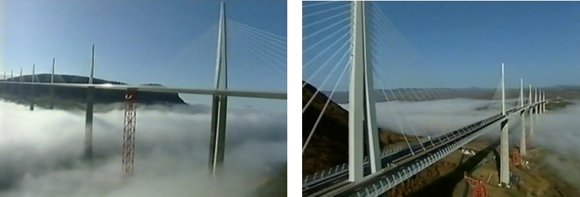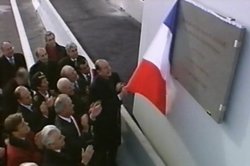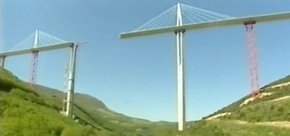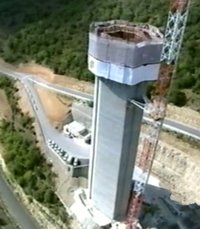| CLICK HERE FOR INDEX PAGE | |
THE MILLAU BRIDGE - SOUTHERN FRANCE |
|
| V. Ryan © 2005 - 2009 | |
 |
|
|
The Millau Bridge is in southern France and crosses the River Tarn in the Massif Central mountains. It was designed by the British architect Lord Foster and at 300m (984 feet) it is the highest road bridge in the world, weighing 36,000 tonnes. The central pillar is higher than the famous French icon, the Eiffel Tower. The Bridge opened in December 2004 and is possibly one of the most breath taking bridges ever built. |
|
|
|
|
|
|
|
|
The bridge towers above the Tarn Valley and the aim of Lord Foster was to design a bridge with the ‘delicacy of a butter fly’. Lord Foster designed a bridge that enhances the natural beauty of the valley, with the environment dominating the scene rather than the bridge. The bridge appears to float on the clouds despite the fact that it has seven pillars and a roadway of 1½ miles in length. On first sight, the impression is of boats sailing on a sea of mist. The roadway threads through the seven pillars like thread through the eye of a needle. |
|
|
The bridge was opened by President Jacques Chirac. In
his speech he praised the design saying that it was a ‘monument to
French engineering genius’ and ‘a miracle of equilibrium’. |
|
|
|
|
|
CONSTRUCTION TECHNOLOGY |
|
|
|
The bridge took only three years to complete with new engineering techniques being employed. The traditional method of building a cable stay bridge involves building sections of the deck (roadway) and using cranes to put them in position. Because of its height, 900 feet above the valley floor, a new technique had to be developed. |
|
First, the towers were built in the usual way, with
steel reinforced concrete. |
|
|
|
|
|
QUESTIONS: 1. Draw a simple map of France and highlight the location of the bridge. Add important towns and cities such as Paris. 2. Explain through the use of diagrams, how the bridge was built. 3. Write some basic facts about the bridge. For instance, its height and weight, it comparison to the Eiffel Tower |
|
|
|
|





